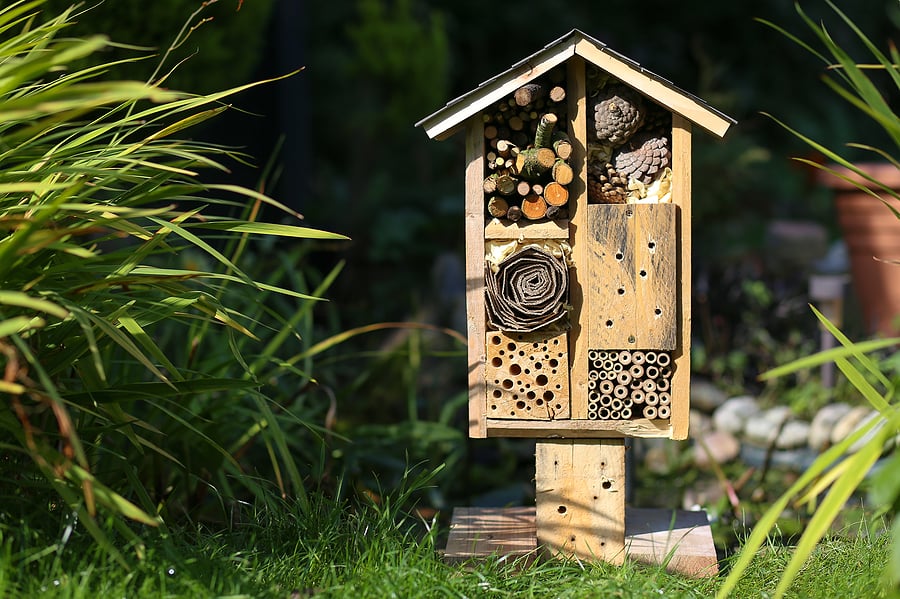How to create a bug hotel for your garden
Creating a bug house, also known as an insect hotel, can be a fun and rewarding project.
It not only provides a haven for beneficial insects, such as bees, ladybirds, and lacewings, but it also contributes to the ecological balance of your garden by promoting pollination and natural pest control.
Here are some creative ideas on how to make a bug house for your garden, tailored to various skill levels and available resources.
1. Basic Bug House for Beginners

Beginners bug hotel
Materials Needed:
- A clean, empty tin can with the top cut off
- Straws, bamboo canes, or hollow stems
- Twine or string
- Scissors
Instructions:
- Prepare the Container: When using a tin can, make sure it’s clean and smooth around the edges to prevent injuries.
- Fill with Materials: Cut the straws or bamboo canes to be slightly shorter than the depth of your container. Pack them tightly into the can or bottle, ensuring there are no large gaps.
- Secure the Bug House: Tie the string around your bug house, or you can drill two holes near the open edge to thread the string through for hanging.
- Positioning: Hang or place your bug house in a sheltered spot in the garden, preferably near flowers to attract pollinators.
2. Intermediate Wooden Bug Hotel

Filling suggestions
Materials Needed:
- Untreated wooden planks or a wooden crate
- Bamboo canes, bricks with holes, drilled wood blocks, straw, and pine cones
- Saw (if cutting wood to size)
- Drill (for making holes in wood)
- Screws or nails
Instructions:
- Construct the Frame: If you’re not using a pre-made wooden crate, construct a box frame from the wooden planks. The size can vary based on your preference and available space.
- Fill the Compartments: Arrange your materials into different sections within the frame. Bamboo canes and drilled blocks are great for solitary bees, while straw and pine cones can provide hiding spots for ladybugs and lacewings.
- Secure the Structure: Use screws or nails to ensure the structure is sturdy. If you’re stacking bricks or blocks, make sure they are stable and won’t easily topple over.
- Placement: Position your bug hotel in a quiet part of the garden, facing south if possible to ensure it gets enough sunlight.
3. Advanced Multi-Story Bug Mansion

Bug hotel in a frame of wooden pallets containing logs, branches, tiles and broken clay flower pots .
Materials Needed:
- A combination of materials from the previous models
- Old wooden pallets
- Roof tiles or corrugated iron for waterproofing the top
- Clay pots, stones, and logs for additional texture and microhabitats
Instructions:
- Foundation and Frame: Use old wooden pallets stacked on top of each other as the main structure. Ensure it’s stable and secure.
- Create Diverse Habitats: Fill each section with a variety of materials. Use logs with holes drilled into them, clay pots turned on their sides, stones for cool, damp hiding spots, and other organic materials.
- Waterproof the Roof: Cover the top with roof tiles, corrugated iron, or even a layer of waterproof fabric to keep the inhabitants dry.
- Decorate and Camouflage: Use natural materials to decorate the outside of your bug mansion, helping it blend in with the garden surroundings.
- Ideal Placement: Place your bug mansion in a sheltered location, ideally with part of it facing south. Near a wildflower meadow or a diverse garden will attract more residents.
Additional Tips:
- Avoid using treated wood or chemicals in your bug house to keep it safe for insects.
- Regularly check and maintain your bug house, clearing out any dead foliage or blockages that might deter new inhabitants.
- Educate yourself on the types of insects you’re trying to attract to provide the most suitable habitats for them.
Creating a bug house is not just a craft project; it’s a step towards supporting your local ecosystem. By offering shelter to beneficial insects, you’re contributing to the health and beauty of your garden in a very direct way.




















